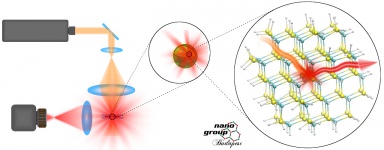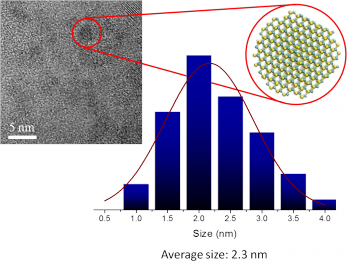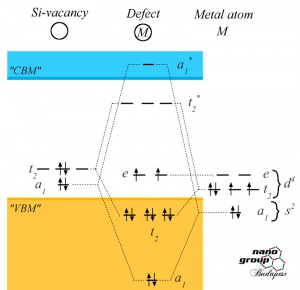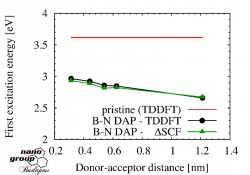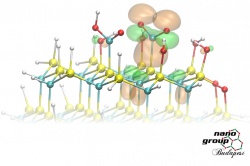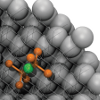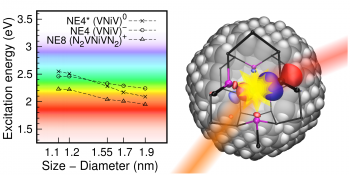Fluorescent semiconductor nanocrystals for biological imaging
Fluorescent biological imaging is a very powerful and vastly improving tool in the detection and tracking of biomolecules. In fluorescent bioimaging, a nanoscale object (biomarker) is attached to the biological molecule of interest, and the fluorescent property of the biomarker enables the optical detection of the biomolecule. The biosensing applications of biomarkers can be divided into two separate families: (i) in vitro, where the biological samples are studied outside their normal biological context and (ii) in vivo where the biomarkers are introduced into a living organisms (animals or humans). Generally QDs intended to be used in in vivo applications have to meet strict requirements, thus their research poses a greater technological challenge. QDs for in vivo biomarker applications shuold be: (i) non-toxic and bioinert, (ii) their hydrodynamical size should be sufficiently small for clearance (with diameter less than 5.5 nm), (iii) they should be photo-stable, so the signal remains stable under operation. Furthermore, it is highly desirable that (iv) they have intense, stable emission in the near-infrared range (700-1300 nm in wavelength) where there is a low-absorption window of cells, often referred as the near-infrared window. Fluorescent biomarkers are made from various different materials (organic molecules and several compound semiconductor), but currently there exists no such solution which fulfills all of the aforementioned criteria and thus can be considered as an ideal tool for biological imaging.
Our group is determined to find solutions to challenges faced in the desing and manufacturing of in vivo biomarkers. In order to achieve our goal, a small experimental group is working on the problem alongside the computer simulation research.
Our research is focused on diammond and silicon carbide nanocrystals, since they are biologically inert and can be produced with very small diameter. However, the fluorescent emission of diamond and silicon carbide nanoparticles are not suitable for biological imaging: they emit light in the UV-visible range instead of the NIR window. In order to make the optical properties of these nanocystals more favorable for biosensing applications, we investigated the effects of different surface treatments and point defects on the fluorescence wavelength.
Experimental results
Molecular-sized SiC nanoparticles
Silicon carbide nanoparticles (SiC NPs) were fabricated by the following techniques:
(1) heat combustion starting from silicon and carbon sources,
(2) wet chemical etching in HF:HNO3 solution,
(3) ultra-sonication,
(4) filtration. This technology results in molecular-size, luminescent, water soluble SiC nanoparticles.
Surface engineering of SiC nanoparticles
Single photon color centers in SiC nanoparticles
Bioimaging with SiC nanoparticles
Computer simulations
We calculate the ground state properties of semiconductor nanocrystals utilizing the Density Functional Theory (DFT), while the optical properties are calculated via the time-dependent density functional theory (TDDFT). In case of very small nanocrystals, even calculations based on the GW approximation are carried out in the framework of many-body perturbation theory. With the help of computer simulations, we aim to find suitable candidates for in vivo biomarkers and to aid the experimental group in the interpretation of their results.
Color centers in silicon carbide nanocrystals
In bulk SiC there are several known point defects which create deep defect levels in the band gap and act as color centers. Introducing these defects into nanocrystalline SiC, the optical properties of the nanocrystals could be drastically altered resulting in near-infrared emitting biomarkers. We investigated silicon vacancy, divacancy and different transition metal (vanadium, molybdenum, tungsten) related point defects in small SiC nanocrystals. Our calculations verified that these defects lower the absorption edge and fluorescent emission energy of the nanocytals and also reduce the size-dependency of the optical properties due to the localized nature of the defect states. Since the optically active defect levels lie deep in the band gap, the shallower surface related defects levels are expected to have less influence on the emission energy compared to the prisitine SiC nanocrystals. Altough the introduction of the investigated defects in ultrasmall nanocrystals poses a major technological challange today, larger (d > 45 nm) silicon nanocrystals containing silicon vancancy defects were already successfully fabricated. <bib id="C2NR32442C"/><bib id="castelletto2014room"/>
Donor-acceptor pairs in silicon carbide nanocrystals
<bib id="somogyi2014computational"/>
The role of surface chemistry in the optical properties of silicon carbide nanocrystals
Due to the large surface to volume ratio of the SiC nanocrystals, the chemical strucutre of the surface has a large infuence on their optical properties. Understanding the surface related phenomena of SiC nanocrystals is of great importance, but also a rather demanding task since the surface chemistry of these ultrasmall nanocrystals is not fully known and very difficult to determine experimentally. While it is generally accepted that the surface of SiC nanocystals in aquaeous solutions is oxygenated, the chemical groups bonding to the surface are not well known. We have investigated the effect of oxygen atoms, hydroxyl, anhydrid, neutral and deprotonated carboxyl groups on the optical properties and vibrational spectra of the SiC nanocrystals. According to our atomistic simulations, the absoprtion edge of the small SiC nanocrystals are lowered in the presence of deprotonated carboxyl groups bonding to the surface. This explains the fact that the measured fluorescence of these nanocystals occurs at higher wavelenghts compared to the calculated emission of nanocrystals with non-oxyganted suraface. <bib id="voros2010absorption"/> <bib id="voros2010absorption_2"/> <bib id="szekrenyes2014chemical"/>
Diamondoids and nanodiamonds for biomarker applications
<bib id="PhysRevB.80.161411"/> <bib id="PhysRevLett.108.267401"/> <bib id="szilvasi2014fluorine"/> <bib id="demjan2014electronic"/>
Silicon-vacancy defects in nanodiamonds
In a cooperation with partners in Russia and Germany, we have taken part in the work of predicting and validating the properties of silicon-vacancy colour centres in nanosized diamond particles. We have contributed with time-dependent DFT calculations, not has been carried out on such large systems so far. We showed that quantum confinement occurs for the valence "band" in nanodiamonds which affects the position of defect related levels in the gap via exchange-correlation effect. As a consequence, the silicon-vacancy luminescence should show a blue shift in ultrasmall nanodiamonds. Nanoparticles for validating experiments have been extracted from a meteorite sample, but production of similar artificial nanoparticles seems to be very prospective in e.g. biosensing. This article has been selected for review in Nature News and Views. <bib id="Vlasov2014" />
Fluorescent nanodiamonds constitute an outstanding alternative to semiconductor quantum dots and dye molecules for in-vivo biomarker applications. Their fluorescence comes from optically active point defects that work as colour centres within the nanodiamond. For practical purposes, these colour centres are required to be photostable as a function of laser power or as a function of the surface of the hosting nanodiamond. Moreover, they need to exhibit a sharp and nearly temperature-independent zero-phonon line. In this study, we show by hybrid density-functional-theory calculations that nickel doped nanodiamonds show the desired properties, opening thus the avenue to practical applications. In particular, we have calculated the lowest excitation energy of nickel-related defects in hydrogenated nanodiamonds both assuming a large concentration of nitrogen (NE8) and no nitrogen. We found that the excitation energy depends very significantly on the size of the nanodiamonds because the transition occurs between a heavily perturbed valence band like state which is subject to quantum confinement. We propose that multi-colour in vivo bioimaging agents can be fabricated with these single colour centres in molecule-sized nanodiamonds when the size of the nanodiamonds will be fine controlled. All of the considered colour centres are paramagnetic and this gives an additional freedom for using them as sensors embedded in nanodiamonds. <bib id="thiering2014" />
Bibliography
<biblist />
